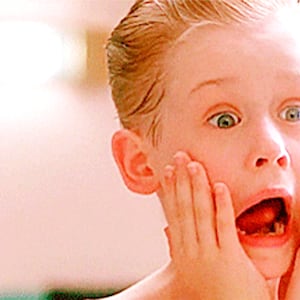Like most holiday films, Home Alone 2 sucks. Even the script seems to acknowledge that the sequel to the massively popular Home Alone, which grossed $476 million globally, is a cynical cash grab. (One of the film’s noteworthy quotes on IMDB is “We did it again! Aah!”) The plot makes no sense. The jokes are worse versions of the jokes from the first movie. Compared with the original Home Alone, which does have fun moments, Home Alone 2 is a joyless slog. But because it’s a cynical cash grab about an entitled, destructive prick whose enemies include anybody who doesn’t enable him, it’s the perfect movie for the Trump era.
Did screenwriter John Hughes intend his screenplay (full title: Home Alone 2: Lost in New York) to be a treatise on the banality of America’s children of privilege? Did he feel the urgency we feel to upend the system before it implodes on itself around the impenetrable fortresses the 1 percent have built for themselves? Did he mean for it to make audiences want to chuck their movie popcorn and eat the rich instead? Almost certainly not. But this is a lunatic overreading of a holiday film, and artists don’t get to control the interpretations of their work.
All I, the viewer, have is the context in which I’m watching the movie, the marijuana edibles I have consumed during at least one (1) of those attempted viewings, the “Oh God what did he do now?” feeling I’ve had the second I’ve opened my eyes every morning for the last three years, and four hours to kill on a holiday flight from one of the coasts to the middle of the country. And you clicked on an article about a 27-year-old bad movie. So you’re complicit in this. Strap in.
ADVERTISEMENT
Home Alone 2 is a fairy tale in reverse about a rich boy who deserves to face consequences, but doesn’t because the whole system is rigged to prop him up at the expense of everybody else. This time, Kevin gets separated from his parents at O’Hare Airport (instead of left home) and accidentally boards a flight to New York instead of one to Miami, because he follows a guy who is wearing a similar jacket to his dad’s (in the first Home Alone, the family thinks they brought Kevin to the airport because the neighbor boy, who is wearing a similar coat to Kevin, gets counted as Kevin). Also, somehow, Kevin’s father entrusted him with his wallet for the chaotic run through the airport? But when Kevin gets to New York, rather than get help he uses his dad’s wallet to book a suite at the Plaza and spends the rest of the film spending his dad’s money, befriending (sort of) a homeless woman, and torturing two guys for robbing a toy store.
Kevin has a world of incredible food available to him in New York, but instead of enjoying any of it, he orders a cheese pizza, which he eats in a limousine. He also orders an elaborate sundae bar to be delivered and prepared bedside. Current visitors to the Plaza who wish to replicate Kevin’s culinary incuriosity and waste a lot of money at the same time can order a “Home Alone Sundae” from Room Service, which contains “sixteen scoops of assorted ice cream, whipped cream, maraschino cherries, M&M’s, brownie bits, chocolate, caramel, and raspberry sauce” and will set diners back $300. It wouldn’t surprise me if an adult Kevin grew up to have a yen for expensive steaks well done with ketchup.
Speaking of which, Donald Trump makes an appearance early in this film. He even has a line! He gives Kevin McCallister directions to the lobby of the Plaza Hotel because, at the time, Trump owned the Plaza and enforced a Trump-y rule that he got a cameo in every Hollywood production that filmed on one of his properties. Years later, after Trump had mismanaged the Plaza into mediocrity, the New York landmark would be passed around from foreign conglomerate to foreign conglomerate. It’s currently owned by Katara Hospitality, which is owned and operated by the government of Qatar. Run into the ground by an image-obsessed Trump, bought up by monied foreign interests. Could John Hughes have known that as goes the Plaza, so goes America?
Trump himself was asked about the film on the morning of Christmas Eve, just after this article was posted, and noted that "a lot of people mention it," meaning his cameo in the movie, "especially around Christmas."
The film invites us to root for the wealthy assholes over the regular folks they ensnare in their irresponsibility. We’re supposed to root for Kevin over the working-class employees at the hotel who dared be skeptical of a small child using a credit card to rack up a $900 room-service bill. We’re supposed to find it tacky that a bellhop expects a tip, and funny when Kevin (and, later, his brother Buzz) tips in chewing gum. We’re supposed to share Mr. and Mrs. McCallister’s annoyance at the patient police officers who can’t instantly help Kevin’s inexplicably wealthy dipshit parents find their son after they lost him for the second year in a row. We’re supposed to empathize with Kevin being so disgusted by a homeless woman who feeds pigeons in Central Park that he says “Sick!” aloud before running away. We aren’t supposed to worry about what Kevin’s wealthy aunt and uncle are going to think when they get back from France to find their 95th Street brownstone transformed into a torture chamber. Everybody who doesn’t affirm or enable Kevin and his awful immediate family is the enemy.
But don’t worry. Kevin does kindness, too. On a trip to an enormous FAO Schwarz-like toy store (bankrolled, again, by money he stole from his father), Kevin learns from the cashier that the toy store donates the contents of its cash registers to a children’s hospital on Christmas Eve. Overcome with the spirit of charity, Kevin pulls out a $20 bill and hands it to him. Wow, Kevin. A regular Sackler.
The other moral-redemption arc is the one where Kevin makes friends with that homeless woman. At first, Kevin thinks she’s gross, but then, after she frees his ankle from where it’s trapped between two boulders, he finds it within the goodness of his limousine cheese-pizza heart to be nice to her. The two go to Carnegie Hall because the evil hotel employees have decided Kevin can’t use a stolen credit card to watch shoot-em-up movies from the 1940s on a king-size bed anymore. She’s taciturn, but just as she’s about to open up with what sounds like a heartbreaking and very interesting backstory, Kevin pipes in and makes it about him.
“I’m just afraid if I do trust someone, I’ll get my heart broken,” the lady explained. “I understand,” Kevin replied. “I had a nice pair of rollerblades. I was afraid to wreck them, so I kept them in a box.” In a later scene, the pigeon lady saves Kevin’s life. Kevin repays her by traipsing from his new, now-with-more-luxury Plaza suite on Christmas Day into Central Park and presenting her with a Christmas tree ornament of a bird. Do you know what homeless people need? To be indoors from the cold. Do you know what they don’t need? An ornament to hang on a tree that they don’t have in a house they don’t have. The fuck is a homeless woman going to do with a Christmas tree ornament of a bird? Invite her inside, you dick! Give her some of your $300 sundae!
Sorry. I digress. On to the major antagonists, who are, actually, kind of shitheads, thanks to the fact that Joe Pesci is so good at playing a shithead (and, in 1992, was one year off winning an Oscar for being so good at playing a shithead, albeit in a non-Home Alone film).
The major antagonists are the same guys who should have died from all the stuff Kevin did to them in the first Home Alone: two small-time crooks who are doing the bad kind of stealing (ripping off a wealthy toy store) instead of the good kind of stealing (using money your father didn’t give you permission to use to go on a hedonistic joyride around the most expensive city in America). In the first Home Alone, Kevin inflicts all manner of pain on them because they’re trying to rob his house. But in the second, he lures them to his rich uncle’s house that’s being renovated and tortures them for fun. Even while under construction, the house he uses to torture them is gorgeous; I used to live right around that neighborhood and if I’m being honest I’d push an old man down a flight of stairs to live in a house that nice. Kevin doesn’t care. He destroys that house that isn’t his, in the name of justice. In the name of justice that could have been achieved sans torture. To paraphrase and grossly misappropriate Adam Serwer, maybe the cruelty is the point.
In the end, Kevin isn’t punished for costing his family thousands, disrupting their travel plans, ruining his uncle’s house, or being a sadistic, fascistic little fuck. His mother finds him because Kevin loves Christmas trees, and her motherly instincts finally kick in enough for her to know where he is: He’s near the Rockefeller Center tree, because ultimately Kevin is a guy who really loves Christmas. We’re going to be saying Merry Christmas again, like you won’t believe!
A modern moviegoer’s journey to maturity contains a few seminal moments. One is when one realizes that the hero in The Breakfast Club is actually the vice principal, and the detention kids are melodramatic assholes who are too sheltered to know how little they know about life. Another is when it dawns on a person that most Christmas movies are actually bad, and nostalgia is chocolate coating over a turd. And a third is when one realizes that every movie about an entitled jerk rewatched in the era of Trump will make you want to set a yacht on fire and donate all of your organs to the Bernie Sanders campaign.







